10.09 to 5.11.2009, 55 days, currency rate 1 € = 2,140 T (Tugrik)

 highlights – Mongolia is a unique country. Unique are its people, nature and wildlife. It is a country with the lowest population density in the world - 1.6 person per square kilometer (2.5 million people live on 1.5 million square kilometers, and nearly half of them live in the capital). In addition, more Mongolians are living outside of their own country - three million live abroad, mainly in Russia and China. Most of Mongolians are still nomads – constantly moving from place to place in searching of better pastures for their animals (that is why you cannot see pigs or chickens with them, as these animals are not suitable for migrating). They moving average 3-5 times a year, disassembling a yurt is taking just a few hours. In Mongolia virtually there are no fences, because the law says that where you settle down, there is your land. It should be called by name - freedom (the unknown thing in the developed countries). But life there is not easy - almost half the country cover a desert, the rest is being dominated by very little fertile soil - steppes and mountains. If you add that this is one of the highest elevated country in the world (average 1580 meters above sea level), it is easy to imagine how harsh winter conditions are here. But even in the summer or autumn, you won't see orchards here. For us, coming here was like a jumping into another world. We started our honeymoon in Georgia and travelled through nine former Soviet republics, where we often felt like returning to our childhood. Suddenly, our Russian language doesn't work here, we couldn't read the menu from which the beef has gone. In the previous countries we were one foot at home, here we are "somewhere else".
highlights – Mongolia is a unique country. Unique are its people, nature and wildlife. It is a country with the lowest population density in the world - 1.6 person per square kilometer (2.5 million people live on 1.5 million square kilometers, and nearly half of them live in the capital). In addition, more Mongolians are living outside of their own country - three million live abroad, mainly in Russia and China. Most of Mongolians are still nomads – constantly moving from place to place in searching of better pastures for their animals (that is why you cannot see pigs or chickens with them, as these animals are not suitable for migrating). They moving average 3-5 times a year, disassembling a yurt is taking just a few hours. In Mongolia virtually there are no fences, because the law says that where you settle down, there is your land. It should be called by name - freedom (the unknown thing in the developed countries). But life there is not easy - almost half the country cover a desert, the rest is being dominated by very little fertile soil - steppes and mountains. If you add that this is one of the highest elevated country in the world (average 1580 meters above sea level), it is easy to imagine how harsh winter conditions are here. But even in the summer or autumn, you won't see orchards here. For us, coming here was like a jumping into another world. We started our honeymoon in Georgia and travelled through nine former Soviet republics, where we often felt like returning to our childhood. Suddenly, our Russian language doesn't work here, we couldn't read the menu from which the beef has gone. In the previous countries we were one foot at home, here we are "somewhere else".
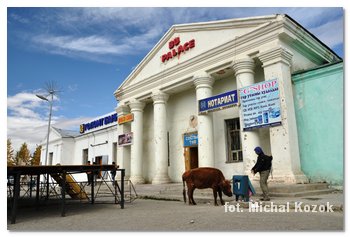 We started our Mongolian trip in the extreme west aimag (province), Bayan-Olgii. To our surprise 90% of this region population are Kazakhs. I should mention that Mongolia and Kazakhstan are not even the neighbors – they are separated by a 20 km land stretch of Russia and China. People say that here is the last place of traditional Kazakh culture, as that one in Kazakhstan has already been destroyed by the Bolsheviks. We liked the small town of Olgii, full of yurts and tiny houses. A cow eating rubbish in front of bank. The bazaar for which you have to pay to enter. People wearing a traditional Mongolian cloth - warm and shining silk with gold. We slept in a poor house hosted by the Peace Corps volunteer. The room is heated by the oven with wood or coal, there is a need to carry water from a well, and to go to the toilet, a hole in the ground, you need to walk 100 meters. For the shower you have to go, like the whole town, to the public baths. We went there and ordered a sauna for an hour (4000 T /per, or 6,000 /2 per - 2 or 3 €; shower 1000 T – 0.5 €). Finally our bodies got some warm, as in Mongolia temperatures are similar to those in Siberia.
We started our Mongolian trip in the extreme west aimag (province), Bayan-Olgii. To our surprise 90% of this region population are Kazakhs. I should mention that Mongolia and Kazakhstan are not even the neighbors – they are separated by a 20 km land stretch of Russia and China. People say that here is the last place of traditional Kazakh culture, as that one in Kazakhstan has already been destroyed by the Bolsheviks. We liked the small town of Olgii, full of yurts and tiny houses. A cow eating rubbish in front of bank. The bazaar for which you have to pay to enter. People wearing a traditional Mongolian cloth - warm and shining silk with gold. We slept in a poor house hosted by the Peace Corps volunteer. The room is heated by the oven with wood or coal, there is a need to carry water from a well, and to go to the toilet, a hole in the ground, you need to walk 100 meters. For the shower you have to go, like the whole town, to the public baths. We went there and ordered a sauna for an hour (4000 T /per, or 6,000 /2 per - 2 or 3 €; shower 1000 T – 0.5 €). Finally our bodies got some warm, as in Mongolia temperatures are similar to those in Siberia.
 We heard that in this region live world famous "eagle hunters”. For centuries the locals caught and train the eagles, which are later used during the hunting. Real hunting takes place only in winter, we were there in the autumn, but even then, I still recommend to see it. We went to the Blue Wolf Travel Agency. The owner made a mistake in calculations, but he didn't lose his face and finally he accepted the first prices he's given to us. So we paid 29.000 T (54 €) for a jeep for 2 days (shared over four people - but normally it should costs 54 € for a jeep per day and probably another 27 € for the second day), 14.500 T (7 €) for a eagle guide /group and another 14.500 T (7 €) /person per horse. Total per person was close to 50.000 T (23 €). Options for accommodation and food were optional - 3.5 € per night, plus two meals a day (3.5 € /day/person), in addition we took with us some vegetables. With drove in jeep from Olgii to Sagsai on the dusty
We heard that in this region live world famous "eagle hunters”. For centuries the locals caught and train the eagles, which are later used during the hunting. Real hunting takes place only in winter, we were there in the autumn, but even then, I still recommend to see it. We went to the Blue Wolf Travel Agency. The owner made a mistake in calculations, but he didn't lose his face and finally he accepted the first prices he's given to us. So we paid 29.000 T (54 €) for a jeep for 2 days (shared over four people - but normally it should costs 54 € for a jeep per day and probably another 27 € for the second day), 14.500 T (7 €) for a eagle guide /group and another 14.500 T (7 €) /person per horse. Total per person was close to 50.000 T (23 €). Options for accommodation and food were optional - 3.5 € per night, plus two meals a day (3.5 € /day/person), in addition we took with us some vegetables. With drove in jeep from Olgii to Sagsai on the dusty  mountain track. Actually it was not a village, but just a vast meadow with white bigger “dots” - yurts and thousands of tiny “dots” - sheep, horses and yaks. What is it yak? An animal which looks like between bison, cow and sheep. It gives milk, tastes like a beef. In Mongolian yurt is more space than in the Kirghiz one. Inside there were three metal beds, small painted table and chairs. In the middle was a stove, a source of light and heat, also serves as a kitchen, and its chimney was going out through the hole in the middle of the dome. This hole can be adjusted - opened during a day to let in a sunlight, and partially closed at night, or completely during the rain. The basic drink is koumiss (airag), an alcoholic beverage created from fermented mare milk (but it also can be donkey, yak, camel or sheep milk). However, we preferred a tea. Hmm, the true Mongolian tea tastes a little different, because salt is used instead a sugar.
mountain track. Actually it was not a village, but just a vast meadow with white bigger “dots” - yurts and thousands of tiny “dots” - sheep, horses and yaks. What is it yak? An animal which looks like between bison, cow and sheep. It gives milk, tastes like a beef. In Mongolian yurt is more space than in the Kirghiz one. Inside there were three metal beds, small painted table and chairs. In the middle was a stove, a source of light and heat, also serves as a kitchen, and its chimney was going out through the hole in the middle of the dome. This hole can be adjusted - opened during a day to let in a sunlight, and partially closed at night, or completely during the rain. The basic drink is koumiss (airag), an alcoholic beverage created from fermented mare milk (but it also can be donkey, yak, camel or sheep milk). However, we preferred a tea. Hmm, the true Mongolian tea tastes a little different, because salt is used instead a sugar. 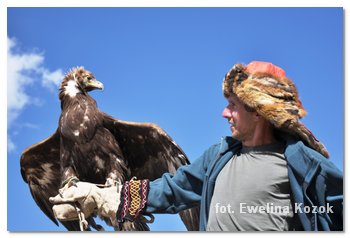 After a snack the kids jumped on their horses and went to catch the free running horses for us (in Mongolia horses to people ratio is 13:1). The old man put on leather hat, and took an eagle on his shoulder. We went ahead through the steppe and meadow, to the mountains. The horses there are small, but strong. The first time in my life I galloped, and due to their sizes I had no psychological barrier – I was happy like a child.
After a snack the kids jumped on their horses and went to catch the free running horses for us (in Mongolia horses to people ratio is 13:1). The old man put on leather hat, and took an eagle on his shoulder. We went ahead through the steppe and meadow, to the mountains. The horses there are small, but strong. The first time in my life I galloped, and due to their sizes I had no psychological barrier – I was happy like a child.
Finally we reached the mountains. Then grandpa's son took the bird and galloped far and high with it. He waited for a signal from his father, who once prepared the bait gave him a sign, and he released the eagle. Predator glided low over the ground, and finally caught up rabbit meat with its claws. The eagle was big and beautiful, between this bird and a master I could see even a physical similarity. However, "hunting" was a little bit disappointing, definitely would be better to see this at winter, when the eagle hunts for alive rabbit, fox or even a wolf. After all we looked straight in the beast eye, we could feel its weight and claws strength while holding it on our arms secured by a special leather glove. The 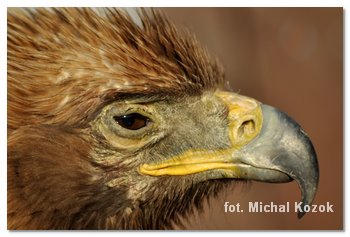 four hours horse trip was worth it, as except hunting the area was breathtaking. Coming back on horseback we stopped at encountered yurts, always welcomed by a salty tea. On the second day we went for a walk on the endless meadows, crossed a few icy streams, we had a chance to look for locals daily work with goats, sheep, horses etc.
four hours horse trip was worth it, as except hunting the area was breathtaking. Coming back on horseback we stopped at encountered yurts, always welcomed by a salty tea. On the second day we went for a walk on the endless meadows, crossed a few icy streams, we had a chance to look for locals daily work with goats, sheep, horses etc.
The end of September and the first weekend of October is a time for official festivals. The first one is organized by Blue Wolf Travel Agency, and the second one perhaps has the government support. It takes place in Sagsai, and except eagle hunting you might see also other regional traditions - mainly horse riding demonstrations and games. Travel Agents charge at least 25 € per day. I do not know if the organizers allow you to watch show without a ticket, as in general speaking you can organize trip to Sagsai by yourself - from Olgii bazaar take an afternoon jeep to Sagsai (3.500 T, 2 €), then remaining distance you can cover on foot (around 90 minutes). You can ask for yurt of Mana family (GPS: N 48° 55.779 'E 89° 34.001'), but probably you can also stay in any yurt encountered on the way, because the Eagle Hunters are quite popular here. For horses our friends bargained down to 7.500 T per day (3.5 €), which is twice cheaper than through agency.
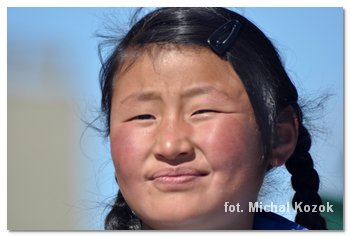 Thanks to couchsurfing in Olgii first time we encountered Peace Corps volunteers. Peace Corps is a US government organization, which recruited mostly young volunteers. They are working mainly in sectors like: education (teaching English), health care and economic development programs. Leaving aside any political motives of this organization, I'm full of respect for these young people (after knowing more than 40 of them, not all of them I respect). They have resigned from the easy daily life in America and decided to work in a third world country for two years, often in conditions far away from normal standards (homes without running water, yurts without electric heating, sometimes even without electricity, etc.). After this period they return to the US without any savings, but with a huge baggage of life experience. For us they were an interesting company, as well possibility to stay overnight, but most importantly a source of knowledge of local customs. Volunteers handed us each other from town to town, so we visited a place generally avoided by tourists. We were in their job places, accompanying them during meetings between themselves and with the locals. It was an interesting experience.
Thanks to couchsurfing in Olgii first time we encountered Peace Corps volunteers. Peace Corps is a US government organization, which recruited mostly young volunteers. They are working mainly in sectors like: education (teaching English), health care and economic development programs. Leaving aside any political motives of this organization, I'm full of respect for these young people (after knowing more than 40 of them, not all of them I respect). They have resigned from the easy daily life in America and decided to work in a third world country for two years, often in conditions far away from normal standards (homes without running water, yurts without electric heating, sometimes even without electricity, etc.). After this period they return to the US without any savings, but with a huge baggage of life experience. For us they were an interesting company, as well possibility to stay overnight, but most importantly a source of knowledge of local customs. Volunteers handed us each other from town to town, so we visited a place generally avoided by tourists. We were in their job places, accompanying them during meetings between themselves and with the locals. It was an interesting experience.
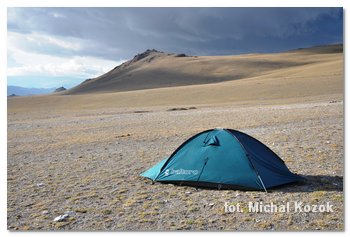 Of course we didn't waste an opportunity to wander around the aimags. The first trekking we did in Tsambagarav Uul National Park. From Olgii we drove in darkness to Khovd direction, with 18 people on board (in a small minibus). When we reached about half the distance we got off in the middle of the night on the windy mountain pass (GPS: N 48° 24.894' E 90° 17.506' – 2100 m). We had to descend a little bit to hide from the wind. The sky was full of stars, but at night was snowing. At morning we put down our white tent, the landscape was surrounded with white peaks, and in the vast valley there were a lot of white yurts. Few hours later when I took off the boots to cross another icy stream (in this journey we crossed more rivers than we slept nights in a bed), the sun was already shining. The first day of this journey we called “skeletons trail”, there were a lot of white animal bones. Except the first valley we didn't meet anyone for the next three days, but we have seen some isolated yurts from the distance. If you ever
Of course we didn't waste an opportunity to wander around the aimags. The first trekking we did in Tsambagarav Uul National Park. From Olgii we drove in darkness to Khovd direction, with 18 people on board (in a small minibus). When we reached about half the distance we got off in the middle of the night on the windy mountain pass (GPS: N 48° 24.894' E 90° 17.506' – 2100 m). We had to descend a little bit to hide from the wind. The sky was full of stars, but at night was snowing. At morning we put down our white tent, the landscape was surrounded with white peaks, and in the vast valley there were a lot of white yurts. Few hours later when I took off the boots to cross another icy stream (in this journey we crossed more rivers than we slept nights in a bed), the sun was already shining. The first day of this journey we called “skeletons trail”, there were a lot of white animal bones. Except the first valley we didn't meet anyone for the next three days, but we have seen some isolated yurts from the distance. If you ever 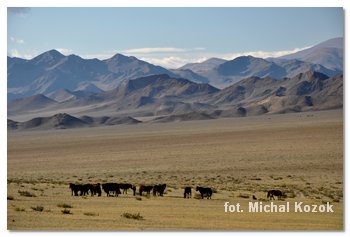 lose a compass, remember that yurt door are always pointed the South. The next days we were going from one valley to another. Each one was showing the vast space between high, but gentle mountains. To cross one valley sometimes we walked 10 km, passing on the way grazing wild horses herds. The most beautiful is fact that you can hike wherever you wish - until a rock cliff or a deep river block you the passage. You can count for local hospitality - even the most isolated yurt will become your shelter if you just ask for it. After three days we reached the main road (GPS: N 48° 22.720' E 91°11.713' – 1560 m) aiming to hitchhike to Khovd. A beautiful area, a vast valley, blue sky and warming sun, but there were many tracks marked by wheels. This is a huge problem when hitchhiking, especially when traffic is almost nil. We sat down along something what seemed to be the most frequented used track, while two kilometers away we saw cloud of dust - a car. We tried to run in its direction, but it had no sense – too far. Finally we decided to walk to the place where all wheels tracks coming together - gorge entry/exit. In this way we didn't miss any more cars, but anyway it did not protect us from seven hours waiting.
lose a compass, remember that yurt door are always pointed the South. The next days we were going from one valley to another. Each one was showing the vast space between high, but gentle mountains. To cross one valley sometimes we walked 10 km, passing on the way grazing wild horses herds. The most beautiful is fact that you can hike wherever you wish - until a rock cliff or a deep river block you the passage. You can count for local hospitality - even the most isolated yurt will become your shelter if you just ask for it. After three days we reached the main road (GPS: N 48° 22.720' E 91°11.713' – 1560 m) aiming to hitchhike to Khovd. A beautiful area, a vast valley, blue sky and warming sun, but there were many tracks marked by wheels. This is a huge problem when hitchhiking, especially when traffic is almost nil. We sat down along something what seemed to be the most frequented used track, while two kilometers away we saw cloud of dust - a car. We tried to run in its direction, but it had no sense – too far. Finally we decided to walk to the place where all wheels tracks coming together - gorge entry/exit. In this way we didn't miss any more cars, but anyway it did not protect us from seven hours waiting. 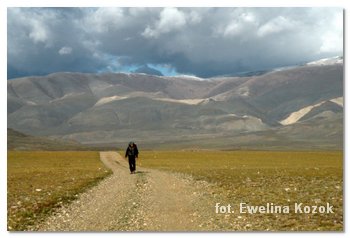 I describe now absurdity of transportation in Mongolia. In this wilderness of thousands tracks, drivers love run in the dark. They are departing Olgii at 4 pm and after two hours drive they are in total darkness, arriving Khovd at 2 am. Once we have seen our driver falling drank from the tavern, so we changed the vehicle. Our new driver looked sober, but unfortunately it turned out that this was only an illusion. He liked looking at us when driving with 80 km/h on gravel road. Finally he broke the wheel, but did not pay attention to it. Shortly he jumped several meters long (with all six passengers in the jeep), but fortunately the car fell on four wheels like a cat thrown from the roof. That was so close to a serious accident. However, I admire local drivers for one thing - orientation in the terrain. How did they know which track to choose, which from hundreds of unmarked forks take, as they don't use GPS, map or compass. But they are reaching the destination, often after more than a thousand kilometers of endless flat steppes, including night driving without any visible characteristic landmarks.
I describe now absurdity of transportation in Mongolia. In this wilderness of thousands tracks, drivers love run in the dark. They are departing Olgii at 4 pm and after two hours drive they are in total darkness, arriving Khovd at 2 am. Once we have seen our driver falling drank from the tavern, so we changed the vehicle. Our new driver looked sober, but unfortunately it turned out that this was only an illusion. He liked looking at us when driving with 80 km/h on gravel road. Finally he broke the wheel, but did not pay attention to it. Shortly he jumped several meters long (with all six passengers in the jeep), but fortunately the car fell on four wheels like a cat thrown from the roof. That was so close to a serious accident. However, I admire local drivers for one thing - orientation in the terrain. How did they know which track to choose, which from hundreds of unmarked forks take, as they don't use GPS, map or compass. But they are reaching the destination, often after more than a thousand kilometers of endless flat steppes, including night driving without any visible characteristic landmarks.
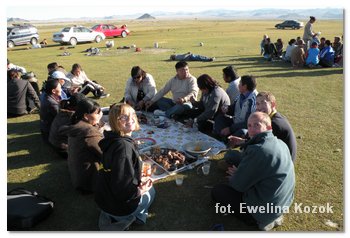 With our American friend (Peace Corps and couchsurfing host in one person) we were invited to “horhog”, a local picnic by the river combined with sheep consumption, playing games, singing songs, and of course drinking vodka. Fortunately we got there after the animal killing ceremony. We managed not to eat a gram of this fatty meat. After a while the meeting transformed into a wild uncontrolled party, and some participants (note that was a school party - our heroes are teachers, ladies and gentlemen, the model and example for students) literally could not stand on their feet. Within few hours three circle of singing teachers have changed in the human battlefield. We could see several ones laying, totally unconscious guys, it shocked us! Some people tried crawling to the car... in attempt to drive it, but luckily they had a problem starting the engine. We have noticed over time that Mongolia unfortunately is not a perfect country, and the most striking negative feature of its society is drinking. Alcohol dominated different meetings like social, cultural, sport, etc. Although, surprisingly this is still a very safe country (even relatively speaking
With our American friend (Peace Corps and couchsurfing host in one person) we were invited to “horhog”, a local picnic by the river combined with sheep consumption, playing games, singing songs, and of course drinking vodka. Fortunately we got there after the animal killing ceremony. We managed not to eat a gram of this fatty meat. After a while the meeting transformed into a wild uncontrolled party, and some participants (note that was a school party - our heroes are teachers, ladies and gentlemen, the model and example for students) literally could not stand on their feet. Within few hours three circle of singing teachers have changed in the human battlefield. We could see several ones laying, totally unconscious guys, it shocked us! Some people tried crawling to the car... in attempt to drive it, but luckily they had a problem starting the engine. We have noticed over time that Mongolia unfortunately is not a perfect country, and the most striking negative feature of its society is drinking. Alcohol dominated different meetings like social, cultural, sport, etc. Although, surprisingly this is still a very safe country (even relatively speaking 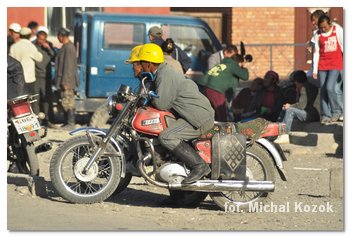 in Ulaanbaatar). However, there wasn't even one single day that we couldn't meet a drank local man (of course not all men drink.). It is therefore not surprising that the owners of hotels, restaurants, pubs, etc. are the women. They also occupy most offices jobs, literally speaking they lead the society.
in Ulaanbaatar). However, there wasn't even one single day that we couldn't meet a drank local man (of course not all men drink.). It is therefore not surprising that the owners of hotels, restaurants, pubs, etc. are the women. They also occupy most offices jobs, literally speaking they lead the society.
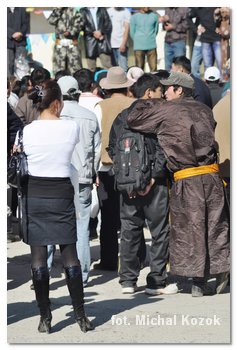 I would not like if that sounds like criticism of Mongolia. I'm trying to pay attention to the different aspects, both positives and negatives. And it's certainly worth visiting Mongolia. For two months stay no one checked our passports (impossible in the former Soviet republics), the police isn't a danger in any case. Interestingly, pubs and night clubs should be officially closed at midnight. However, the general procedure is bribing the police, that the pub can continue the party. So after midnight you have no reason to call police, because they will not come. We also liked to see a cow in front of a bank, money exchange office in a car, motor-taxi drivers in the building construction helmets, old men in traditional dress next to a girl in short skirt and in high heels, or sports car parked beside a horse. It is a country of contrasts and interesting things, that have already not rights to happen in "Western" civilization. People are generally helpful and friendly.
I would not like if that sounds like criticism of Mongolia. I'm trying to pay attention to the different aspects, both positives and negatives. And it's certainly worth visiting Mongolia. For two months stay no one checked our passports (impossible in the former Soviet republics), the police isn't a danger in any case. Interestingly, pubs and night clubs should be officially closed at midnight. However, the general procedure is bribing the police, that the pub can continue the party. So after midnight you have no reason to call police, because they will not come. We also liked to see a cow in front of a bank, money exchange office in a car, motor-taxi drivers in the building construction helmets, old men in traditional dress next to a girl in short skirt and in high heels, or sports car parked beside a horse. It is a country of contrasts and interesting things, that have already not rights to happen in "Western" civilization. People are generally helpful and friendly.
 Our next stop was Bayankhongor - ajmag capital. However, there is no attraction to stop the tourists. We arrived there by bus. Ah, what a bus! It looked like a urban one and here is serving a very long-distance on 4x4 gravel tracks. Well, our ride lasted 23 hours. People are behaving like they know each other for a long time - vodka helped with it. They're saying it's necessary, because than you do not mind the dust, cold, wind, etc. We however, this time instead of vodka we have chosen sleeping bags and books. In Bayankhongor wandering around was a pleasure. We climbed up the hill with the sacred stupa. Young students, not used to tourists, presented a bracelet to Ewelina. From the top there is a good view of hundreds of yurts close to each other. Here we tried to organize a jeep to the Gobi desert. It wasn't here any local travel agency, and hire a
Our next stop was Bayankhongor - ajmag capital. However, there is no attraction to stop the tourists. We arrived there by bus. Ah, what a bus! It looked like a urban one and here is serving a very long-distance on 4x4 gravel tracks. Well, our ride lasted 23 hours. People are behaving like they know each other for a long time - vodka helped with it. They're saying it's necessary, because than you do not mind the dust, cold, wind, etc. We however, this time instead of vodka we have chosen sleeping bags and books. In Bayankhongor wandering around was a pleasure. We climbed up the hill with the sacred stupa. Young students, not used to tourists, presented a bracelet to Ewelina. From the top there is a good view of hundreds of yurts close to each other. Here we tried to organize a jeep to the Gobi desert. It wasn't here any local travel agency, and hire a  driver from the bazaar is a risky, because he might be completely not familiar with the sites on which we wanted to go. And desert is a serious case.
driver from the bazaar is a risky, because he might be completely not familiar with the sites on which we wanted to go. And desert is a serious case.
In Arvaikheer we slept in a very nicely decorated yurt. It belonged to one of the American volunteers. This tent wrapped with leather is a good invention - warm in a winter, cooling in a summer. The town held local fair-trade. On the main square within a few hours many yurts were assembled and animal market smelled by goats and sheep. In addition to traditional products you could buy a washing machine or a computer. For us the highlight was the costumes. There were lots of people in traditional silk clothes, meanwhile young ladies had high heels, short skirts and tight T-shirts with Mickey Mouse.
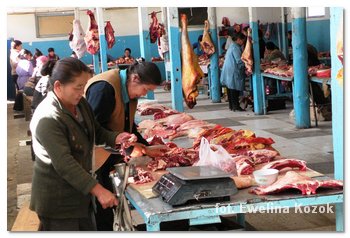 We had enough small towns and soms (villages) and decided that it's a time to go to Ulaanbaatar. We arrived to the capital at night (how could be otherwise). Bus station looked like a petrol station in the middle of the suburb. Later we met our couchsurfer host. His house was already full, nine people slept on the floor, the other travelers or American volunteers. Every day someone new was coming, someone was leaving - the party was keep going. As well we were leaving the apartment and coming back, but finally we decided to rent a separate room there, until we solved a visa problem (Chinese working visa). In this way we spent in the capital about a month, so we know the town quite well. Theoretically an average traveler spends here only as needed to organize visas or transport. But everyone who travels in Mongolia will get here (it's the transportation hub), so if for any reasons someone would like to follow our way, I described below places worth (or not) to recommend.
We had enough small towns and soms (villages) and decided that it's a time to go to Ulaanbaatar. We arrived to the capital at night (how could be otherwise). Bus station looked like a petrol station in the middle of the suburb. Later we met our couchsurfer host. His house was already full, nine people slept on the floor, the other travelers or American volunteers. Every day someone new was coming, someone was leaving - the party was keep going. As well we were leaving the apartment and coming back, but finally we decided to rent a separate room there, until we solved a visa problem (Chinese working visa). In this way we spent in the capital about a month, so we know the town quite well. Theoretically an average traveler spends here only as needed to organize visas or transport. But everyone who travels in Mongolia will get here (it's the transportation hub), so if for any reasons someone would like to follow our way, I described below places worth (or not) to recommend.
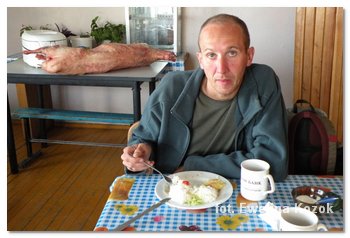 In Ulaanbaatar finally we were able to eat properly, we changed our menu from lamb and mutton (not our favorite meat) for a tasty beef and cheese. The city was a paradise for us after a long stay in the province. European restaurants dominate the Peace Ave (above 5.000 T for a dish, 2.5 €). Mongolian lamb smell terrible, but it's much cheaper (dishes from 1.500 T). We recommend a vegetarian Luna Blanca - Juulchin Gudami St. (parallel to the Peace Avenue, in the same block as the main post office). While strolling in the city be aware for three “dangers”. The first one are pickpockets, they are insolent and don't afraid police, but they are not aggressive. The second one are crazy drivers - there is no pedestrian priority. The third trap are not covered holes in the pathway.
In Ulaanbaatar finally we were able to eat properly, we changed our menu from lamb and mutton (not our favorite meat) for a tasty beef and cheese. The city was a paradise for us after a long stay in the province. European restaurants dominate the Peace Ave (above 5.000 T for a dish, 2.5 €). Mongolian lamb smell terrible, but it's much cheaper (dishes from 1.500 T). We recommend a vegetarian Luna Blanca - Juulchin Gudami St. (parallel to the Peace Avenue, in the same block as the main post office). While strolling in the city be aware for three “dangers”. The first one are pickpockets, they are insolent and don't afraid police, but they are not aggressive. The second one are crazy drivers - there is no pedestrian priority. The third trap are not covered holes in the pathway.
As for museums your student ISIC card is working here, for camera you pay extra, descriptions are often in English. By the way, someone who has planned museums in this city have 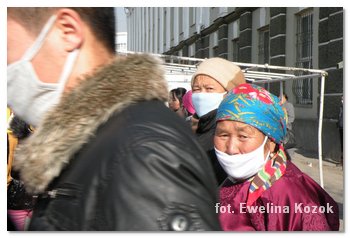 to be either crazy or loved puzzles. In addition to the three major museums, the rest is somewhere between suburbs blocks. Nobody recognizes addresses. Where is the Hunting Museum? Opposite the green building with a Korean restaurant. And where is this restaurant? When you find the street corner with a monastery, and the street corner where the police station is, you have to turn left. Uh-huh ... that's so easy. In the tourist information on Sukhbaatar Sq you can get a city plan and information in English. Meanwhile we walked around the city in the masks on our faces. Not because we got completely crazy here. Almost everyone walked in the masks, black, white or blue. Without the masks you weren't allowed enter the museums, internet cafes (if you're lucky to find any open one). All pubs and restaurants had to be closed after 9 pm. All because of H1N1 virus - little epidemic of confusion.
to be either crazy or loved puzzles. In addition to the three major museums, the rest is somewhere between suburbs blocks. Nobody recognizes addresses. Where is the Hunting Museum? Opposite the green building with a Korean restaurant. And where is this restaurant? When you find the street corner with a monastery, and the street corner where the police station is, you have to turn left. Uh-huh ... that's so easy. In the tourist information on Sukhbaatar Sq you can get a city plan and information in English. Meanwhile we walked around the city in the masks on our faces. Not because we got completely crazy here. Almost everyone walked in the masks, black, white or blue. Without the masks you weren't allowed enter the museums, internet cafes (if you're lucky to find any open one). All pubs and restaurants had to be closed after 9 pm. All because of H1N1 virus - little epidemic of confusion.
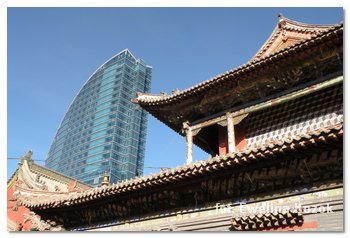 Museum of Natural History will complement the knowledge of Mongolia. We liked the dinosaur skeletons. Some huge, others small, but interesting (exp. Bones of two monsters who died during bloodthirsty combat when the dune collapsed on them). A lot of eggs (dinosaur's of course) and meteorites were found into Gobi sands. However, the National Museum of Mongolian History we did not like so much. There were grave stones, costumes, jewelry, and everyday use objects etc. We do not recommend it, unless someone is more interested in the topic. Because for us, this Mongolian “history” is still alive - in the steppe where nomads still use the same tools, play the same games, make horse milk in the identical leather container etc. Of course the plastic and satellite came here as well, but we felt this history more among alive people than dead (museum). The museum of religion, Choijin Lama Temple, which long time ago was the monastery (but only for 20 years), and survived as a museum, is presented Mongolian Buddhism. There is a lot of gold items, prayer flags, large or small Buddha statues.
Museum of Natural History will complement the knowledge of Mongolia. We liked the dinosaur skeletons. Some huge, others small, but interesting (exp. Bones of two monsters who died during bloodthirsty combat when the dune collapsed on them). A lot of eggs (dinosaur's of course) and meteorites were found into Gobi sands. However, the National Museum of Mongolian History we did not like so much. There were grave stones, costumes, jewelry, and everyday use objects etc. We do not recommend it, unless someone is more interested in the topic. Because for us, this Mongolian “history” is still alive - in the steppe where nomads still use the same tools, play the same games, make horse milk in the identical leather container etc. Of course the plastic and satellite came here as well, but we felt this history more among alive people than dead (museum). The museum of religion, Choijin Lama Temple, which long time ago was the monastery (but only for 20 years), and survived as a museum, is presented Mongolian Buddhism. There is a lot of gold items, prayer flags, large or small Buddha statues. 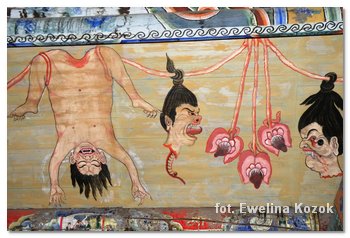 Ceiling paintings are quite original – human pieces in details. A little macabre, but interesting. We liked the location - in the city center its wooden walls are contrasting with the modern glass skyscraper at the background. Winter Palace is the larger version of the museum of religion (note: closed on Wednesday and Thursday). 1.5 km further south is a 16-meter high golden Buddha statue, and not far above it a War Memorial (free), where you can see the city view. We went even further south and climbed some surrounding hills. Gandan Khiid is a Buddhist monastery with praying monks. This is a complex of several buildings, and in the main one there is a 26-meter high copper Buddha (covered with gold). Entry fee to the main building is 3.500 T, but walking on the courtyard is free of charge.
Ceiling paintings are quite original – human pieces in details. A little macabre, but interesting. We liked the location - in the city center its wooden walls are contrasting with the modern glass skyscraper at the background. Winter Palace is the larger version of the museum of religion (note: closed on Wednesday and Thursday). 1.5 km further south is a 16-meter high golden Buddha statue, and not far above it a War Memorial (free), where you can see the city view. We went even further south and climbed some surrounding hills. Gandan Khiid is a Buddhist monastery with praying monks. This is a complex of several buildings, and in the main one there is a 26-meter high copper Buddha (covered with gold). Entry fee to the main building is 3.500 T, but walking on the courtyard is free of charge.
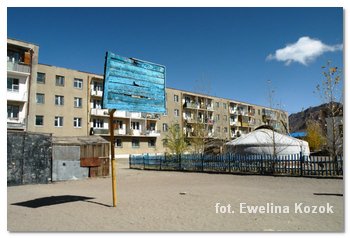 Much more fun we had at the International Intellectual Museum. It consists a large number of puzzles, toys, chess etc. And what does it have to do with Mongolia? Did you know that the yurt is really a puzzle? Well, if it can be dissemble and assemble into a smaller parts. Do you know how formerly doors were locked? After all, there were no padlocks, but two logically connected metal wires could confuse any thief. And what charming chess collection they have. For example, ones you can play with yurts, other time you can lead Chinggis Khaan Army against Japanese Sumo team.
Much more fun we had at the International Intellectual Museum. It consists a large number of puzzles, toys, chess etc. And what does it have to do with Mongolia? Did you know that the yurt is really a puzzle? Well, if it can be dissemble and assemble into a smaller parts. Do you know how formerly doors were locked? After all, there were no padlocks, but two logically connected metal wires could confuse any thief. And what charming chess collection they have. For example, ones you can play with yurts, other time you can lead Chinggis Khaan Army against Japanese Sumo team.  Guide shows toys, tricks, gives us puzzles and tasks to solve. It was a great challenge for our brains.
Guide shows toys, tricks, gives us puzzles and tasks to solve. It was a great challenge for our brains.
After visiting exciting museum of intellect, we went to relax ourselves in a concert Tumen Ekh Song & Dance Ensemble at the State Youth & Children's Theatre. We recommend it, the concert was lovely, we like the steppe music. Our favourite musical instruments is "morin khuur" - strings are made from horse hair and one end is carved into horse head. The rest of the orchestra are local pipes, trumpets and cymbals. But what made the concert different – “Khoomii”, the throat singing. Man made an 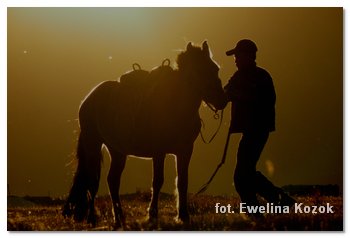 unbelievable sound without opening his lips. There were also traditional dances. Theatre is hard to find as there are some constructions around - it is across the street from the Bajangol Hotel, several hundred meters south. Concerts are performing at every evening. We also recommend a folk music in rock version performed by "Altan Urag" band. They often playing in Ikh Mongol pub, on the eastern side of the circus, on Thursdays and Sundays at 9:30 pm.
unbelievable sound without opening his lips. There were also traditional dances. Theatre is hard to find as there are some constructions around - it is across the street from the Bajangol Hotel, several hundred meters south. Concerts are performing at every evening. We also recommend a folk music in rock version performed by "Altan Urag" band. They often playing in Ikh Mongol pub, on the eastern side of the circus, on Thursdays and Sundays at 9:30 pm.
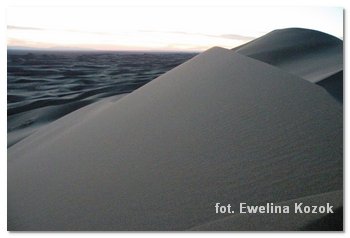 We did some short trips around the country. The main Mongolia attraction is the Gobi Desert, the best highlight. I was there eight years ago, and now have decided not to go only for financial reasons, a bit too expensive for me. Ewelina did some research, as she wanted to find a group to share the costs. She was visiting all the main hostels in Ulaanbaatar and everywhere she left her email. The cheapest one proved to be UB Guest House - 20 € per day. But Khongor Guest House first organized her a group - 24 € per day per person. Prices in both cases included minibus with petrol and driver, guide, admission fees, accommodations, three meals a day and an hour camel ride. Tours are offered from 6 to 19 days. You should check the program, as sometimes the main attraction - big sand dunes called Khongoryn Els, are not in the program (instead small dunes are in the offer – but they are not comparable). The cheapest way you can go to the Gobi is by renting a car with a driver (7 passengers). Choose the driver from the agency, not from the street - because then you are sure he knows the way. This option usually costs daily between 23-28 € plus fuel, approximately 0.7 € per liter (minibuses are thirsty, nearly 20 L /100 km).
We did some short trips around the country. The main Mongolia attraction is the Gobi Desert, the best highlight. I was there eight years ago, and now have decided not to go only for financial reasons, a bit too expensive for me. Ewelina did some research, as she wanted to find a group to share the costs. She was visiting all the main hostels in Ulaanbaatar and everywhere she left her email. The cheapest one proved to be UB Guest House - 20 € per day. But Khongor Guest House first organized her a group - 24 € per day per person. Prices in both cases included minibus with petrol and driver, guide, admission fees, accommodations, three meals a day and an hour camel ride. Tours are offered from 6 to 19 days. You should check the program, as sometimes the main attraction - big sand dunes called Khongoryn Els, are not in the program (instead small dunes are in the offer – but they are not comparable). The cheapest way you can go to the Gobi is by renting a car with a driver (7 passengers). Choose the driver from the agency, not from the street - because then you are sure he knows the way. This option usually costs daily between 23-28 € plus fuel, approximately 0.7 € per liter (minibuses are thirsty, nearly 20 L /100 km). 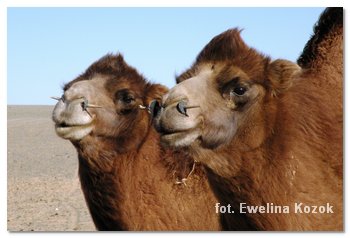 The farther from the capital, the more expensive petrol is. You can sleep in yurts or tents if you prefer, you might cook by yourself. Khongor Guest House rents tents and sleeping bags for free, if you take a car from them. Other office to rent a cheap car is for example Sky Radiant on Peace Ave. If you are traveling in a larger group you might consider the following option to cross the Gobi – by local bus go to Bayankhongor, then drive by post minibus to Bayangovi (ask at the post office, minibus leaving on Friday and maybe also in one other day) and there hire a jeep.
The farther from the capital, the more expensive petrol is. You can sleep in yurts or tents if you prefer, you might cook by yourself. Khongor Guest House rents tents and sleeping bags for free, if you take a car from them. Other office to rent a cheap car is for example Sky Radiant on Peace Ave. If you are traveling in a larger group you might consider the following option to cross the Gobi – by local bus go to Bayankhongor, then drive by post minibus to Bayangovi (ask at the post office, minibus leaving on Friday and maybe also in one other day) and there hire a jeep.
There are some Ewelina's photos from Gobi:
I went to the northeast, where I were hiking through swamps, mountain ridges and birch and pine forests. After a long time on treeless plains I liked the forest. I found the Chinggis Khaan birthplace (GPS: N 49°03.323' E 111°38.664'), and water spring, from according to the legend he drank (GPS: N 49°02.767' E 111°36.865'). While discussing about Chinggis Khaan with Mongolians remember that for them he is a national hero, 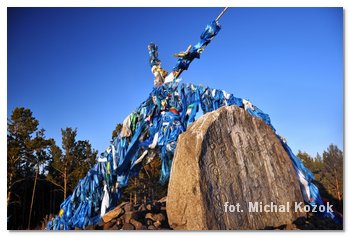 so it's more polite to not present them the Western point of view. Anyway, the only known history about him have been written by educated people conquered by him – in this circumstances who would describe the invader positively? Birthplace of the great leader is in fact just a symbolic stone mound, I pitched a tent there. Onon Balij National Park didn't impressed me as much as deserted part of Mongolia, but it was also interesting to see. First of all there were no paths, I had to finding ways - sometimes I got stuck in the river mud, or on the river bank without possibility to cross it, or sometimes I used scary tiny footbridge made from the tree trunk. There were a few yurts, and much more the wooden Siberian hats (Russian border is a day walk from here). Nights in the tent were a little bit cold in late October. I returned to Dadal after three days and boarded the post minibus (Mondays and Thursdays) to Ondorkhaan. When finally we obtained a visa to China, at the same day we were already at the airport. But we took with us the Mongolian steppe, space and music in our hearts.
so it's more polite to not present them the Western point of view. Anyway, the only known history about him have been written by educated people conquered by him – in this circumstances who would describe the invader positively? Birthplace of the great leader is in fact just a symbolic stone mound, I pitched a tent there. Onon Balij National Park didn't impressed me as much as deserted part of Mongolia, but it was also interesting to see. First of all there were no paths, I had to finding ways - sometimes I got stuck in the river mud, or on the river bank without possibility to cross it, or sometimes I used scary tiny footbridge made from the tree trunk. There were a few yurts, and much more the wooden Siberian hats (Russian border is a day walk from here). Nights in the tent were a little bit cold in late October. I returned to Dadal after three days and boarded the post minibus (Mondays and Thursdays) to Ondorkhaan. When finally we obtained a visa to China, at the same day we were already at the airport. But we took with us the Mongolian steppe, space and music in our hearts.
| town |
site |
price in T |
€/ per |
duration |
note |
comments |
| Olgi |
eagle hunting |
194,600 T/ 4persons |
€22.7 |
2 days |
super |
jeep, horse, eagle included; food and night for extra charge |
| Ulaanbaatar |
Museum of Natural History |
stud. 1000 T |
€0.5 |
2 h |
worth |
normal 2500 T, dinosaurs |
| Museum of Mongolian History |
stud. 1000 T |
€0.5 |
2 h |
ok |
normal 2400 T, ethnology |
| Choijin Lama Temple Museum |
stud. 1000 T |
€0.5 |
30' |
ok |
normal 2500 T |
| Winter Palace |
2500 T |
€1.2 |
1 h |
ok |
|
| Gandan Khiid |
- |
- |
30' |
ok |
normal 3,500 T |
| International Intellectual Museum |
3000 T |
€1.4 |
2 h |
worth |
with English speaking guide |
| Tumen Ekh Song & Dance Ensamble |
stud. 8000 T |
€3.7 |
1.5 h |
worth |
normal 12,000 T, traditional music, singing and dancing |
| |
|
|
€30 |
|
|
|

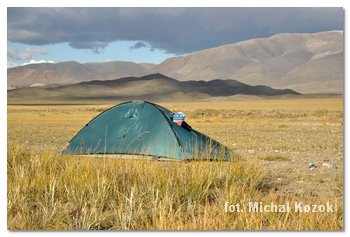 accommodation – during the whole journey we mostly used tent, couchsurfing and Peace Corps hospitality. In the capital we also used a guesthouse few times. Thanks to a tent we saved a lot of money and it gave us the possibility of sleeping anywhere on the way. Mongolia is extremely safe. Towns in the western part are usually surrounded by hills and it is easily to find camping place within walking distance from the center. In Olgii, Khovd and Bayankhongor you can camp peacefully next to the river, and in Avaikheer on the hills. During trekking there are millions of options, however since mid-October can be a bit freezing.
accommodation – during the whole journey we mostly used tent, couchsurfing and Peace Corps hospitality. In the capital we also used a guesthouse few times. Thanks to a tent we saved a lot of money and it gave us the possibility of sleeping anywhere on the way. Mongolia is extremely safe. Towns in the western part are usually surrounded by hills and it is easily to find camping place within walking distance from the center. In Olgii, Khovd and Bayankhongor you can camp peacefully next to the river, and in Avaikheer on the hills. During trekking there are millions of options, however since mid-October can be a bit freezing.
Very often we used couchsurfing (CS) website. It is a form of free accommodation, but shouldn't be treated as a free hotel. To surf a couch you need to have a time and like the people company (we always read a host profile). Sometimes it is unfair when someone gives the price for food or offers the tours. Sometimes, what may happen especially  in Mongolia, host is located 20 kilometers from the place where it supposed to be. In Mongolia we encountered young American Peace Corps volunteers, as they are often advertised on CS. They are sent to villages for more then two years, living with locals - often in the yurts. Meeting them led us deeper through back door to the Mongolian culture.
in Mongolia, host is located 20 kilometers from the place where it supposed to be. In Mongolia we encountered young American Peace Corps volunteers, as they are often advertised on CS. They are sent to villages for more then two years, living with locals - often in the yurts. Meeting them led us deeper through back door to the Mongolian culture.
We used Guesthouses only in the capital. I recommend Khongor GH – clean dormitory, everyone has a locker and bed curtain. The only disadvantage is a lack of meeting place, so travellers are gathering in the small kitchen or at the office. UB Guesthouse was a little bit cheaper: dorm 9.000 T (4 € /per), has a common room where people can meet, and very friendly staff (we didn't stay there but they helped us with our Chinese mail correspondence). Golden Gobi (same prices as the previous one) is clean and nice, but the dormitory is also a common living room, so you might not sleep well there. We do not recommend the Bold Guesthouse - dirty and often no owner there, anyone could enter from the street.
| town |
hotel and address |
N |
accommodation |
price per night |
€/ per |
note |
comments |
| Sagsai |
during "eagle hunting" |
1 |
yurt floor |
9000 T/ per |
€4.2 |
5 |
simple condition |
| Ulaanbaatar |
Khongor Guest House, Peace Ave 15, Apt. 6. |
1 |
dormitory |
7000 T/ per |
€3.2 |
7 |
free internet, tea and breakfast |
| 1 |
double room |
10000 T/ per |
€4.6 |
6 |
| privet flat |
16 |
double room |
7000 T/ room |
€1.6 |
8 |
room renting |
| |
in wild |
7 |
|
|
|
|
|
| |
couchsurfing |
22 |
|
|
|
|
|
| |
hospitality |
6 |
Peace Corps |
|
|
|
|
| |
in transport |
1 |
|
|
|
|
|
| |
|
55 |
|
|
€37 (19) |
|
|

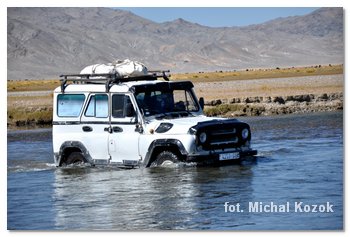 transport – is a little problematic in Mongolia. Almost from anywhere you can reach the capital, but sometimes is difficult to get anywhere else outside the capital, even to the neighboring ajmag (province). Often you need to go around via Ulaanbaatar.
transport – is a little problematic in Mongolia. Almost from anywhere you can reach the capital, but sometimes is difficult to get anywhere else outside the capital, even to the neighboring ajmag (province). Often you need to go around via Ulaanbaatar.
Bus tickets can be purchased in one day in advance in the bus station or directly from the bus. You can book a seat from the minibus driver – pay when departing. There is no additional charge for luggage. I have no idea why, but departures are often late afternoons, and arrivals to the destinations in the middle of the night. If you cannot find transportation on the bazaar, you can try at the post office. Postal parcels delivery vans ride to various towns around the aimag and also take passengers.
 We also tried hitchhike. You should expect a fee, but it is not the biggest problem. Not only that traffic is a little, the point is that it's hard to find the main exit from the town, as there are simply hundreds of signs and tracks. The second big hurdle is the fact that cars usually go full, so it's hard to count on a empty run. We tried hitchhike twice and each time we were waiting for seven hours, but of course it depends on luck.
We also tried hitchhike. You should expect a fee, but it is not the biggest problem. Not only that traffic is a little, the point is that it's hard to find the main exit from the town, as there are simply hundreds of signs and tracks. The second big hurdle is the fact that cars usually go full, so it's hard to count on a empty run. We tried hitchhike twice and each time we were waiting for seven hours, but of course it depends on luck.
In Ulaanbaatar you can move around by cheap buses (300 T) or by trolley (200 T). Unfortunately they don't run early in the morning and late evening. Taxi might be any car that you stop (from the city center to the train station about 3,000 T, 1.5 €). Getting to the airport take bus number 11
| day |
destination |
transport |
price in T |
€/ per |
duration |
km |
| 65 |
Kosh-Agach (Russia) - Olgii |
car |
data in "Russia" |
6 h |
Russia 90 Mongolia 80 |
| 67 + 68 |
Olgii - Sagsai + return |
2x jeep |
data in "highlights" |
2x 1 h |
2x 40 |
| 67 |
around Sagsai |
horse |
data in "highlights" |
4 h |
20 |
| 69 |
Olgi - 1/2 way to Khovd |
minibus |
10,000 T |
€4.7 |
5 h |
130 |
| 70 - 72 |
1/2 way to Khovd - 1/3 way to Khovd |
walk |
- |
- |
2.5 days |
67 |
| 72 |
1/3 way to Khovd - Khovd |
2x hitchhiking, jeep |
6,000 T |
€2.8 |
2 h |
76 |
| 75 |
Khovd - Bayankhongor |
bus |
45,000 T |
€21.0 |
23 h |
756 |
| 78 |
Bayankhongor - Avaikheer |
hitchhiking, jeep |
8,000 T |
€3.7 |
3.5 h |
184 |
| 82 |
Avaikheer - Ulaanbaatar |
bus |
14,000 T |
€6.5 |
7 h |
398 |
| 88 + 94 |
Ulaanbaatar - Ondorkhaan + return |
2x bus |
2x 10,000 T |
2x€4.7 |
2x 5.5 h |
2x 334 |
| 90 + 93 |
Ondorkhaan - Dalat + return |
2x post minibus |
2x 10,700 T |
2x€5.0 |
2x 6 h |
2x 254 |
| 90 - 93 |
around Dalat |
walk |
- |
- |
2.5 days |
44 |
| |
city transport |
taxi, bus |
6,300 T/ per |
€2.9 |
- |
- |
| |
|
|
|
€61 |
|
55 |

 visa – we arranged our in Almaty, Kazakhstan. Nice and smoothly, without any additional documents so popular in Central Asia (exp. invitation letter). The cost is 27 €, waiting time is five working days. We asked for priority processing for 41 € and we received the visa the next morning. The embassy is open on Mon, Tue, Thu and Fri, the documents submission is between 9:30 and 12, an pick ups should be in the afternoons.
visa – we arranged our in Almaty, Kazakhstan. Nice and smoothly, without any additional documents so popular in Central Asia (exp. invitation letter). The cost is 27 €, waiting time is five working days. We asked for priority processing for 41 € and we received the visa the next morning. The embassy is open on Mon, Tue, Thu and Fri, the documents submission is between 9:30 and 12, an pick ups should be in the afternoons.
Visa can be extended only once. To do this visit the immigration office south of Ulaanbaatar 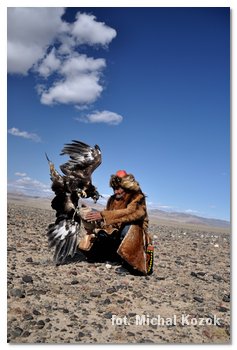 center - behind the Bayangol hotel, but before the bridge - on your right. One month extension costs 40 € - it includes every day extension (30 days times 2.700 T), plus the administration fee 5.000 T and application form for 1.000 T. The minimum extension is 7 days and the maximum 30. Payment can be paid at the bank in the same building. You need to have passport photo copy and two photos. Processing time - two days.
center - behind the Bayangol hotel, but before the bridge - on your right. One month extension costs 40 € - it includes every day extension (30 days times 2.700 T), plus the administration fee 5.000 T and application form for 1.000 T. The minimum extension is 7 days and the maximum 30. Payment can be paid at the bank in the same building. You need to have passport photo copy and two photos. Processing time - two days.
The border with Russia in Olgii - on the internet is written that it's closed all weekend, but the border guards told us that they are working on Saturday. You cannot cross this border on foot - 20 km land strip need to be covered by a vehicle.
Applying for a Chinese visa (tourist or working) - details are in article “China introduction”.
Mongolia has embassies in most developed countries. However, in Central Asia only in Kazakhstan.
back to top



























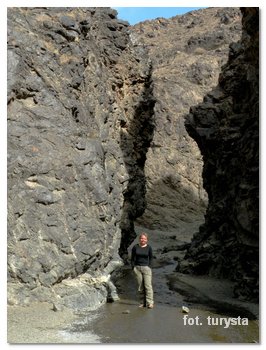
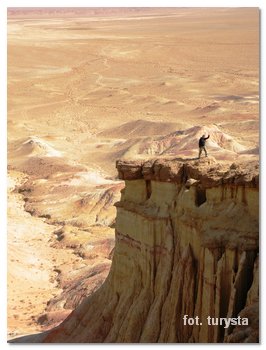

![]()


![]()


![]()

